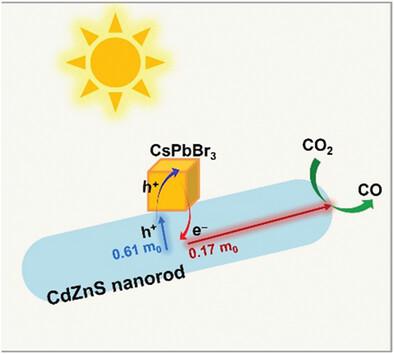Our official English website, www.x-mol.net, welcomes your
feedback! (Note: you will need to create a separate account there.)
In Situ Constructed Perovskite–Chalcogenide Heterojunction for Photocatalytic CO2 Reduction
Small ( IF 13.0 ) Pub Date : 2023-05-08 , DOI: 10.1002/smll.202300841 Yuhan Wang 1 , Jin Wang 1, 2 , Meng Zhang 1 , Song Zheng 1 , Jiahui Wu 1 , Tianren Zheng 1 , Guocan Jiang 1, 2 , Zhengquan Li 1, 2
Small ( IF 13.0 ) Pub Date : 2023-05-08 , DOI: 10.1002/smll.202300841 Yuhan Wang 1 , Jin Wang 1, 2 , Meng Zhang 1 , Song Zheng 1 , Jiahui Wu 1 , Tianren Zheng 1 , Guocan Jiang 1, 2 , Zhengquan Li 1, 2
Affiliation

|
Perovskite nanocrystals (PNCs) are promising candidates for solar-to-fuel conversions yet exhibit low photocatalytic activities mainly due to serious recombination of photogenerated charge carriers. Constructing heterojunction is regarded as an effective method to promote the separation of charge carriers in PNCs. However, the low interfacial quality and non-directional charge transfer in heterojunction lead to low charge transfer efficiency. Herein, a CsPbBr3–CdZnS heterojunction is designed and prepared via an in situ hot-injection method for photocatalytic CO2 reduction. It is found that the high-quality interface in heterojunction and anisotropic charge transfer of CdZnS nanorods (NRs) enable efficient spatial separation of charge carriers in CsPbBr3–CdZnS heterojunction. The CsPbBr3–CdZnS heterojunction achieves a higher CO yield (55.8 µmol g−1 h−1) than that of the pristine CsPbBr3 NCs (13.9 µmol g−1 h−1). Furthermore, spectroscopic experiments and density functional theory (DFT) simulations further confirm that the suppressed recombination of charge carriers and lowered energy barrier for CO2 reduction contribute to the improved photocatalytic activity of the CsPbBr3–CdZnS heterojunction. This work demonstrates a valid method to construct high-quality heterojunction with directional charge transfer for photocatalytic CO2 reduction. This study is expected to pave a new avenue to design perovskite–chalcogenide heterojunction.
中文翻译:

原位构建钙钛矿-硫族化物异质结用于光催化二氧化碳还原
钙钛矿纳米晶体(PNC)是太阳能转化为燃料的有希望的候选者,但其光催化活性较低,这主要是由于光生电荷载流子的严重重组。构建异质结被认为是促进PNC中载流子分离的有效方法。然而,异质结中的低界面质量和非定向电荷转移导致电荷转移效率低。在此,通过原位热注射方法设计并制备了CsPbBr 3 –CdZnS异质结,用于光催化CO 2还原。研究发现,异质结中的高质量界面和 CdZnS 纳米棒 (NR) 的各向异性电荷转移能够实现 CsPbBr 3 –CdZnS 异质结中电荷载流子的有效空间分离。CsPbBr 3 –CdZnS异质结实现了比原始CsPbBr 3 NCs(13.9 µmol g -1 h -1 )更高的CO产率(55.8 µmol g -1 h -1)。此外,光谱实验和密度泛函理论(DFT)模拟进一步证实,抑制载流子复合和降低CO 2还原能垒有助于提高CsPbBr 3 –CdZnS异质结的光催化活性。这项工作展示了构建用于光催化CO 2还原的定向电荷转移的高质量异质结的有效方法。这项研究有望为钙钛矿-硫族化物异质结的设计开辟一条新途径。
更新日期:2023-05-08
中文翻译:

原位构建钙钛矿-硫族化物异质结用于光催化二氧化碳还原
钙钛矿纳米晶体(PNC)是太阳能转化为燃料的有希望的候选者,但其光催化活性较低,这主要是由于光生电荷载流子的严重重组。构建异质结被认为是促进PNC中载流子分离的有效方法。然而,异质结中的低界面质量和非定向电荷转移导致电荷转移效率低。在此,通过原位热注射方法设计并制备了CsPbBr 3 –CdZnS异质结,用于光催化CO 2还原。研究发现,异质结中的高质量界面和 CdZnS 纳米棒 (NR) 的各向异性电荷转移能够实现 CsPbBr 3 –CdZnS 异质结中电荷载流子的有效空间分离。CsPbBr 3 –CdZnS异质结实现了比原始CsPbBr 3 NCs(13.9 µmol g -1 h -1 )更高的CO产率(55.8 µmol g -1 h -1)。此外,光谱实验和密度泛函理论(DFT)模拟进一步证实,抑制载流子复合和降低CO 2还原能垒有助于提高CsPbBr 3 –CdZnS异质结的光催化活性。这项工作展示了构建用于光催化CO 2还原的定向电荷转移的高质量异质结的有效方法。这项研究有望为钙钛矿-硫族化物异质结的设计开辟一条新途径。





















































 京公网安备 11010802027423号
京公网安备 11010802027423号